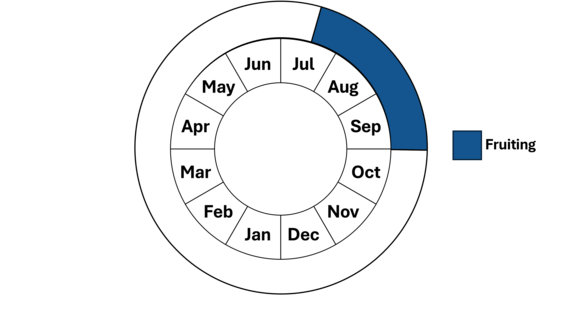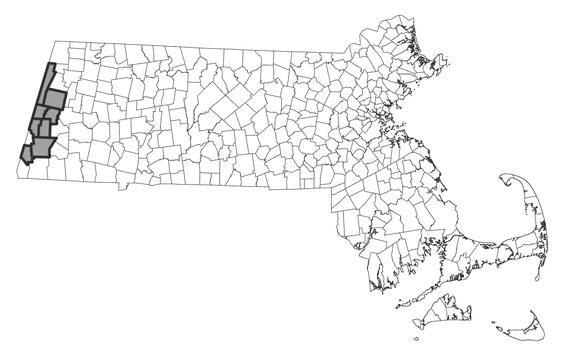- Scientific name: Potamogeton hillii
- Species of Greatest Conservation Need (MA State Wildlife Action Plan)
- Special Concern (MA Endangered Species Act)
Description
Hill’s pondweed, a member of the Pondweed family (Potamogetonaceae), is an herbaceous, submersed aquatic plant with very slender stems. The branched stems reach up to 1 m (3.3 ft) in length, and both stems and leaves are entirely beneath the surface of the water. The genus name comes from the Greek words potamos and geiton, meaning river and a neighbor, respectively. (Slow-moving streams are one of the plant's typical habitats). Hill's pondweed’s pale green, three (occasionally five)-nerved leaves are 3-7 cm (1.2-2.75 in) long, linear in shape and only 1-2.2 mm wide. Most of the leaf tips end in bristles. On each side of the mid-rib of the leaves are one to two rows of translucent tissue called lacunae. The stipules (appendages at the base of leaf stalks or leaves) are fibrous and whitish. The small inflorescence on Hill's pondweed consists of one to four small, crowded flowers. Both leafy pondweed (P. foliosus) and straight-leaved pondweed (P. strictifolius) could be mistaken for Hill's pondweed. Of the two, only leafy pondweed is typically associated with P. hillii. In contrast to Hill's pondweed, leafy pondweed has four to six flowers in its inflorescences. In addition, its fruits are smaller than those of P. hillii--only 1.5 to 2.7 mm (0.06–0.11 in). Both the leaves and branches of straight-leaved pondweed are rigid. Unlike Hill's pondweed, straight-leaved pondweed has distinct glands where the leaves grow out from the stem and a distinctive, bold margin around the leaves.
Life cycle and behavior
The buoyant 3-3.6 mm (0.12-0.14 in) long fruits mature in August.

Population status
Hill's pondweed is listed under the Massachusetts Endangered Species Act as a species of special concern. All listed species are protected from killing, collecting, possessing, or sale and from activities that would destroy habitat and thus directly or indirectly cause mortality or disrupt critical behaviors. The special concern status means that, although the species is not presently endangered or threatened in the state, it is rare and the species could become threatened due to a continuing decline, small numbers of plants, or limited habitat. All current and historic records are from Berkshire County. About one-third of all global occurrences of Hill's pondweed occur in Massachusetts. Hill's pondweed is also considered rare in Connecticut, Michigan, Ohio, Pennsylvania, and Vermont.
Distribution and abundance
Hill's pondweed has been documented as occurring in Ontario, Vermont, New York, western Connecticut, Michigan, western Massachusetts, Pennsylvania, and Ohio. It is very local in distribution and one of the least common pondweeds in the United States. NatureServe ranks Hill's pondweed as globally Vulnerable, G3, since it is somewhat uncommon throughout its range.

Distribution in Massachusetts. 1999-2024. Based on records in the Natural Heritage Database.
Habitat
Hill's pondweed’s best habitat is cold, clean, alkaline bodies of water, where it provides a source of food for waterfowl and shelter for various aquatic organisms. It grows in various other habitats as well: some examples of the Massachusetts habitats of Hill's pondweed are swamps, marshy areas, rivers, and various ponds—including farm and beaver ponds. Associated species include floating pondweed (Potamogeton natans), leafy pondweed (P. foliosus), naiad or bushy pondweed (Najas flexilis), coontail (Ceratophyllum demersum), northern water-weed (Elodea canadensis), yellow water-lily (Nuphar variegata), white water lily (Nymphaea odorata), a spike rush (Eleocharis acicularis), and duckweeds (Lemna sp.). Non-vascular stoneworts (Chara spp.) are often in the same calcium-rich waters as Hill's pondweed.
Healthy habitats are vital for supporting native wildlife and plants. Explore habitats and learn about conservation and restoration in Massachusetts.
Threats
Many of the sites with Hill's pondweed have non-native species that threaten to crowd out this species.
Conservation
Sites should be monitored for invasions of exotic plants; if exotic plants are crowding and out-competing this species, a plan should be developed, in consultation with the Natural Heritage & Endangered Species Program, to remove the invaders. All active management of rare plant populations (including invasive species removal) is subject to review under the Massachusetts Endangered Species Act and should be planned in close consultation with the MassWildlife’s Natural Heritage & Endangered Species Program.
References
NatureServe. 2010. NatureServe Explorer: An online encyclopedia of life [web application]. Version 7.1. NatureServe, Arlington, Virginia. Available http://www.natureserve.org/explorer. (Accessed: December 17, 2010 ).
USDA, NRCS. 2010. The PLANTS Database (http://plants.usda.gov, 17 December 2010). National Plant Data Center, Baton Rouge, LA 70874-4490 USA. http://plants.usda.gov/java/profile?symbol=POHI4
Contact
| Date published: | May 5, 2025 |
|---|